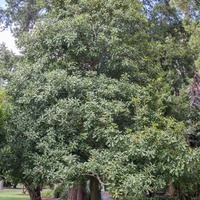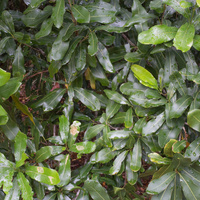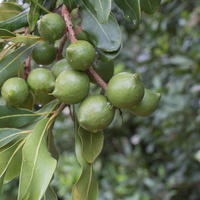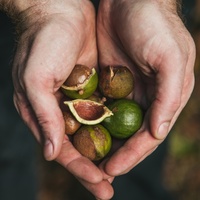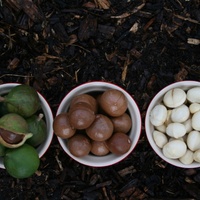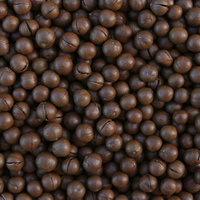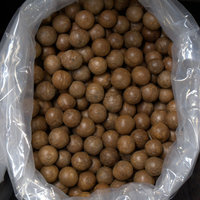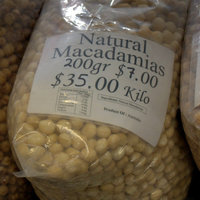Description
Macadamia is a nut-bearing tree originating in eastern Australia, in subtropical rainforests extending from coastal northern New South Wales to southeast Queensland.
Through cultivation, its range has expanded to other parts of the subtropics. Within Australia to just south of the town of Mackay, and outside of Australia to countries such as Hawaii, where it is now a commercially important nut crop.
In natural forests, it may be a small tree up to 15 m (50 ft) tall with a straight trunk up to 30 cm (1 ft) in diameter. On open sites and in cultivation, it is more typically 5 to 10 m (15 to 30 ft) tall with a short, low-branching trunk and a densely leafy pyramidal or rounded crown. The bark is brown, smooth on young trees, becoming slightly rough on older trees.
Leaves are club-shaped, leathery, 10 to 30 cm ( 4 to 12 in) long, bronze-red when they emerge, turning glossy green and have wavy margins that are sometimes toothed or prickly. They are spirally arranged towards the ends of the branches and remain on the tree throughout the year.
Flowers are small, creamy-white, petalless tubes borne in numbers of one to three hundred or more, in flower spikes 10 to 30 cm (4 to 12 in) long, resembling bottle brushes. They bloom in the dry season, from winter to spring in subtropical Australia, the spikes numbering possibly in the thousands hanging from the ends of the branches, almost completely hiding the green foliage from view.
Although the flowers are perfect, having both female and male parts, only a few flowers on each spike develop into fruit. The fruit, when mature, are roundish with a prominent nipple and with smooth, green leathery peel, somewhat resembling a young lime.
The peel surrounds a round nut with a glossy brown shell that is very hard and difficult to crack open. It protects an edible, round kernel with creamy, nutty, oily white flesh. As the fruit ripens, the peel splits, releasing the nut, which falls to the ground.
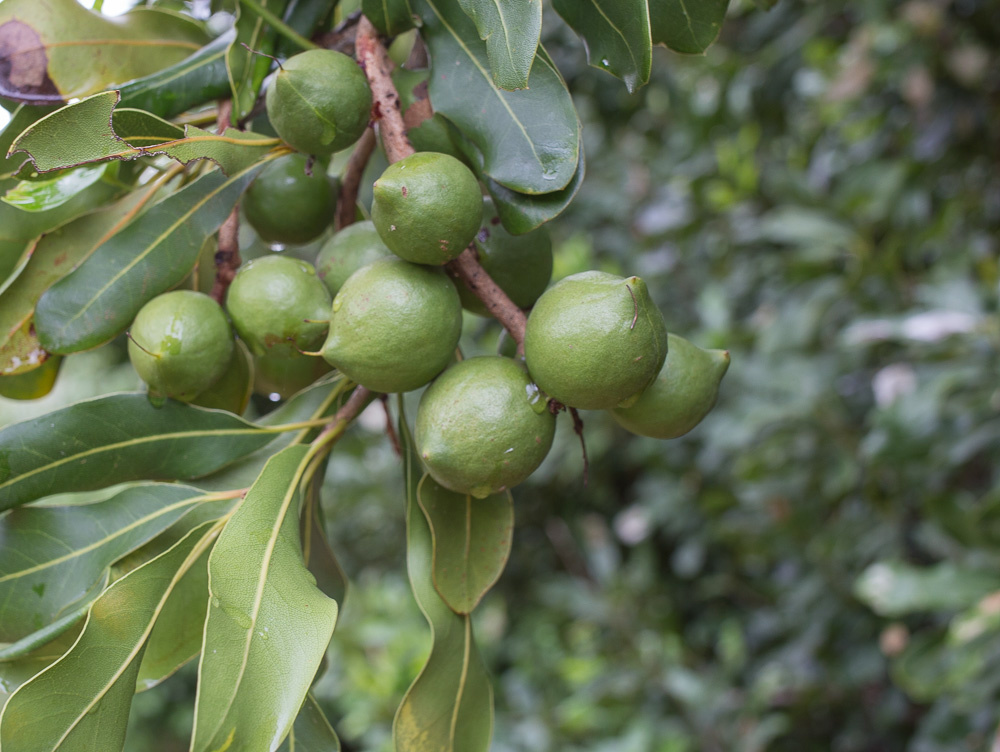
Use
The fallen nuts are collected from the ground, stored and left to dry for a week before they are eaten or processed. Macadamias are a popular nut, cultivated commercially and sold for eating as they are or in various snack foods and confectionery, either raw, roasted, salted, unsalted, coated in chocolate (Theobroma cacao), baked in cookies or added to ice cream. They also yield an edible oil marketed as a high-end salad oil. More recently, they are being used to make a milk substitute sold under the 'Milkadamia' brand.
The flowers produce enough nectar for honey production to be economical, with yields of 25 to 50 kgs (55 to 110 lbs) per colony per season reported for Australia. The pure honey is light to medium amber, of medium density, slow to granulate and with a rich, moderately sweet flavour reminiscent of butterscotch or malt and caramel.
Climate
Macadamia grows naturally and is productive in humid subtropical and tropical mid-elevation climates, generally frost-free areas with annual lows of 11 to 19°C, annual highs of 20 to 32°C, annual rainfall of 800 to 3700 mm and a dry season of 5 months or less, extending to 8 months with irrigation or groundwater.
A more cold-hardy species of Macadamia known as the Rough-Shelled Macadamia (Macadamia tetraphylla) has been cultivated successfully in cooler climates, such as the San Francisco Bay area in California. Most Macadamia cultivated in California is a hybrid cross (Macadamia integrifolia x Macadamia tetraphylla)
Macadamia trees may fail to flower and fruit or do so poorly in areas where the average low of the coldest month is above 16°C (61°F).
Growing
New plants are usually produced vegetatively, using cuttings and air-layering (circumposing) techniques. Although new plants are also started from seed, there is great variation in yield and nut characteristics in seedling trees. Vegetatively produced trees also come into bearing sooner, around two years earlier than seedling trees, when three to four years old.
Performs best on deep, rich, free-draining clay and loam soils of a moderately acid to neutral nature, generally with a pH of 5.0 to 7.0, and on sites with full to partial sun exposure. It has poor tolerance to slow-draining or saturated soils and strong winds.
Yields reported for Australia range from 12 to 15 kgs (26 to 33 lbs) of in-the-shell nuts per tree per year. However, yields in Hawaii are significantly higher.
Problem features
It is listed as a weed in at least one reference publication. Still, there does not appear to be any record of it anywhere as a serious weed, despite it being widely introduced and cultivated in the tropics. It is assessed as a low weed risk species for Hawaii by the Hawaii Pacific Weed Risk Assessment (HPWRA) project.
The milky sap exuded by part of the plant is high in Hydrogen cyanide (HCN), also known as prussic acid. This poisonous compound should be treated with caution.
Where it grows
References
Books
-
Axtell, B. L & Fairman, R. M 1992, Minor oil crops, Food and Agriculture Organization of the United Nations (FAO), Rome
-
Barwick, M., et al. 2004, Tropical & subtropical trees : a worldwide encyclopaedic guide, Thames and Hudson, London
-
Doran, J. C & Turnbull, J. W. 1997, Australian trees and shrubs : species for land rehabilitation and farm planting in the tropics, 2nd ed, Australian Centre for International Agricultural Research (ACIAR), Canberra, Australian Capital Territory
-
Editors of Sunset Magazine 2012, The New Western Garden Book: The Ultimate Gardening Guide, 9th edition, Sunset Publishing Corporation, California
-
Elevitch, C. R. & Thaman, R. R. 2011, Specialty crops for Pacific islands, 1st ed, Permanent Agriculture Resources, Hawaii
-
Elevitch, C. R. 2006, Traditional trees of Pacific Islands: their culture, environment and use, 1st edition, Permanent Agriculture Resources, Holualoa, Hawaii
-
Fellows, P. 1997, Traditional foods : processing for profit, Intermediate Technology, Technical Centre for Agricultural and Rural Co-operation, London
-
Gunstone, F. D. 2011, Vegetable oils in food technology : composition, properties and uses, 2nd ed, Wiley-Blackwell, Hoboken, New Jersey
-
Holliday, I. 2002, A field guide to Australian trees, 3rd revised editon, New Holland Publishers, Frenchs Forest, New South Wales
-
Jensen, M. 1999, Trees commonly cultivated in Southeast Asia : an illustrated field guide, 2nd ed., Food and Agricultural Organisation of the United Nations (FAO) Regional Office for Asia and the Pacific (RAP), Bangkok
-
Jex-Blake, A. J. 1957, Gardening in East Africa : a practical handbook, 4th ed., Royal Kenya Horticultural Society, Longmans, Green and Company, London
-
Kennard, W. C. & Winters, H. F. 1960, Some fruits and nuts for the tropics, Miscellaneous Publication No. 801, U.S. Department of Agriculture, Federal Experimental Station, Mayaguez, Puerto Rico
-
Leech, M. 2013, Bee Friendly: A planting guide for European honeybees and Australian native pollinators, Rural Industries Research and Development Corporation (RIRDC), Canberra, Australian Capital Territory
-
Macmillan, H. F. 1943, Tropical planting and gardening : with special reference to Ceylon, 5th ed, Macmillan Publishing, London
-
Page, P. E. 1984, Tropical tree fruits for Australia, Queensland Department of Primary Industries (QLD DPI), Brisbane
-
Perkins, K. D. & Payne, W. 1981, Guide to the poisonous and irritant plants of Florida, Florida Cooperative Extension Service, Gainesville, Florida
-
Perry, B. 2010, Landscape plants for California gardens: an illustrated reference of plants for California landscapes, Land Design Publishing, Claremont, California
-
Randall, R. P. 2002, A global compendium of weeds, R.G. and F.J. Richardson Press, Melbourne
-
Rosengarten, F. 1984, The book of edible nuts, Walker and Company Publishing, New York
-
Tindall, H. D. & Rice, L. W. 1990, Fruit and vegetable production in warm climates, International ed., Macmillan, London
Articles, Journals, Reports and Working Papers
-
Morton, J.F. 1964, Honeybee Plants of South Florida, Proceedings of the Florida State Horticultural Society, Vol 77:415-436.
-
Watson, B.J., & Moncur, M. 1985, Guideline criteria for determining survival, commercial and best mean minimum July temperatures for various tropical fruit in Australia (Southern Hemisphere), Department of Primary Industries Queensland (DPI QLD), Wet Tropics Regional Publication, Queensland
-
Wenkam N.S. & Miller C.D. 1965, Composition of Hawaii fruits (Bulletin 135), University of Hawaii, Honolulu
